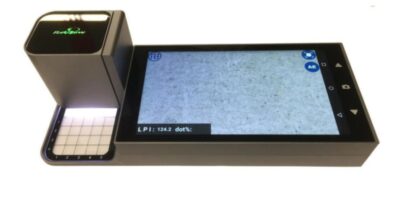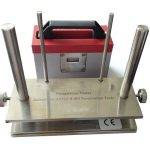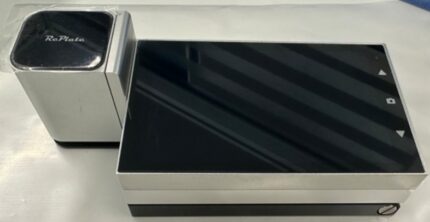Perspiration Tester
$0.00
Perspiration Tester

Perspiration Tester
A Perspiration Tester is a lab device used to evaluate the colorfastness of textiles to artificial perspiration (sweat). It simulates the effects of human sweat—both acidic and alkaline—on dyed or printed fabrics under controlled temperature and pressure.
Purpose of Perspiration Tester:
– To test how fabrics react to body sweat and determine whether dyes bleed, fade, or transfer onto adjacent materials.
Working Principle:
- Fabric samples are treated with synthetic perspiration solution (acidic or alkaline).
- They are sandwiched with adjacent fabric and placed between glass or acrylic plates.
- The assembly is loaded into the tester and pressed under specific pressure.
- it’s then incubated at 37°C (body temperature) for a fixed time (typically 4 or 16 hours).
- Afterward, color change and staining are evaluated using a gray scale.
Applications of Perspiration Tester:
– Garment and sportswear testing
– Quality control in textile processing
– Compliance with standards like ISO 105 E04, AATCC 15
Benefits of Perspiration Tester:
- Accurate Sweat Simulation – Mimics real-life effects of acidic and alkaline perspiration on fabrics.
- Improves Product Quality – Ensures textiles retain color and don’t bleed or stain when worn.
- Supports Standard Compliance – Follows ISO and AATCC test standards for global market approval.
- Protects Brand Reputation- Reduces customer complaints due to dye transfer or fading.
- Simple and Repeatable- Provides consistent pressure and conditions for reliable results.
- Multi-Sample Testing- Tests multiple specimens at once, saving time in labs.
- Durable and Low Maintenance- Robust frame with minimal moving parts makes it long-lasting and easy to care for.
Features of Perspiration Tester:
- Stainless Steel Frame – Corrosion-resistant body for durability and long-term use.
- Multi-Sample Capacity – Can hold up to 20 or more specimens for batch testing.
- Standardized Loading Weight- Applies uniform pressure (usually 12.5 kPa) across all samples.
- Removable Plates – Glass or acrylic plates ensure even contact and easy cleaning.
- Compact Design- Space-saving, bench-top model ideal for lab environments.
- Complies with Test Standards – Meets ISO 105 E04, AATCC 15, and related perspiration fastness standards.
- Ease of Operation – Simple loading, unloading, and incubation process.
- High-Temperature Resistance – Can be used inside incubators at 37°C or ovens as required.
How to Use a Perspiration Tester:
- Prepare the Test Solution – Mix artificial acidic or alkaline perspiration as per standard (ISO or AATCC).
- Cut the Fabric Samples – Cut both the test fabric and adjacent white fabric (usually cotton) to standard size.
- Soak the Samples – Immerse the fabric sandwich (test + adjacent) in the test solution for 30 minutes.
- Remove Excess Liquid – Gently squeeze or blot to remove extra moisture—do not dry.
- Load in the Tester- Place each sandwich between glass or acrylic separator plates in the tester.
- Apply Pressure – Tighten the top plate or place the standard weight on top to apply uniform pressure.
- Incubate – Keep the loaded tester in an oven or incubator at 37°C for 4–16 hours (depending on the method).
- Accurate Sweat Simulation – Mimics real-life effects of acidic and alkaline perspiration on fabrics.
- Improves Product Quality – Ensures textiles retain color and don’t bleed or stain when worn.
- Supports Standard Compliance – Follows ISO and AATCC test standards for global market approval.
- Protects Brand Reputation- Reduces customer complaints due to dye transfer or fading.
- Simple and Repeatable- Provides consistent pressure and conditions for reliable results.
- Multi-Sample Testing- Tests multiple specimens at once, saving time in labs.
- Durable and Low Maintenance- Robust frame with minimal moving parts makes it long-lasting and easy to care for.
- Dry and Evaluate – Remove, air dry the samples, then assess color change and staining using a gray scale.
- Fabric samples are treated with synthetic perspiration solution (acidic or alkaline).
- They are sandwiched with adjacent fabric and placed between glass or acrylic plates.
- The assembly is loaded into the tester and pressed under specific pressure.
- it’s then incubated at 37°C (body temperature) for a fixed time (typically 4 or 16 hours).
- Afterward, color change and staining are evaluated using a gray scale.

Perspiration Tester
Related products
Pantone book
Pantone Book

Pantone Book
- Formula Guide (Solid Coated & Uncoated) – For spot color printing.
- Color Bridge – Shows Pantone spot colors alongside CMYK equivalents.
- Pantone Fashion, Home + Interiors (FHI) – For textiles, soft goods, and home decor.
- Pantone CMYK and Pastels & Neons Guides – For process printing and special effect colors.
- Formula Guide (Solid Coated & Uncoated)
- Color Bridge Guide (Coated & Uncoated)
- CMYK Guide (Coated & Uncoated)
- Pastels & Neons Guide
- Metallics Guide
- FHI Color Guide (TPG – Paper)
- FHI Cotton Passport & Cotton Planner (TCX – Textile)
- FHI Polyester Swatch Book
- Pantone SkinTone Guide
- Pantone Plastic Standard Chips

Pantone Book
Card winding machine
Card Winding Machine

Card Winding Machine

Card Winding Machine
Automatic Bobbin Hydro extractor
Automatic Bobbin Hydro extractor

Automatic Bobbin Hydro extractor
- Computer system: Foshan HuaGao Chinese English computer, equipped with LG PLC.
- Electromagnetic valve: Ningbo Jiaerling
- Frequency converter: Use Made in China frequency converters.
- Pump: self-made high head and large flow centrifugal water pump.
- Main pump motor: Anhui Wannan Motor.
- Master cylinder liquid level: Use 4-20mA analog signal output.
- Level of deputy temporary worker: use foam water level gauge. (American Mike)
- Temperature detection and display: digital temperature display instrument, dual temperature measuring probes.
- The safety system has a triple cylinder head safety interlock mechanism, and the main cylinder is equipped with a stainless
- steel safety valve.
- Heat exchanger: external spacer heating.
- Feeding system: Quantitative feeding based on the process curve.
- Circulation system: The main pump flows internally and externally, which is automatically controlled by a computer or manually controlled by a relay.
- Valves: Y valves are used for heating, stainless steel Y valves are used for single inlet and single row, and other Y valves are produced by joint ventures.
- Temperature control: on-off temperature control, controlled by a computer, with automatic heating, cooling, and insulation functions.
- Dyeing method: air cushion type.
- Opening method: manual opening.
- Surface treatment: polishing inside and outside the cylinder.
- Cage: Each dyeing machine is equipped with butterfly blades and self-locking locks.
- Body plate: high-quality stainless steel. (S31603)
- Bath ratio: 1:5-1:6
- Chemical material system: including heating and water adding functions, including overflow type salt melting device.
- Overflow cleaning: The cleaning port is installed on the upper part of the cylinder port, and the bottom of the cylinder is filled with water, while the cylinder is drained for easy cleaning.
- Commutation method: Novel "U" type commutation.
- Random accessories: Each model comes with one set of mechanical seals, pot mouth rings, and reversing seals for the main and auxiliary pumps.

Automatic Bobbin Hydro extractor
Controller For IR Dyeing Machine
Controller For IR Dyeing Machine

IR Dyeing machine controller
- Temperature Control:- Precisely regulates the infrared heaters to maintain uniform temperature across the dye bath. - Supports customizable heating curves (ramp-up, hold, and cool-down phases).
- Programmable Logic Control (PLC): - Allows operators to set and automate dyeing programs for different fabrics and dye types. - Supports multiple recipes or programs for different batches.
- Real-Time Monitoring and Feedback: - Monitors parameters like temperature, fabric rotation, bath circulation, and timing. - Provides real-time data and alarms for deviations.
- Touchscreen Interface / HMI (Human Machine Interface): - User-friendly interface for configuring and monitoring processes. - Multi-language support and graphical display of process curves.
- Data Logging and Traceability: - Records process data for quality control and traceability.
- Energy Efficiency Optimization: - Manages IR heater output to reduce energy usage. - Often includes features for auto shut-off or idle mode.
- Safety Features: - Includes emergency stop, over-temperature protection, and fault detection systems. 8. Connectivity: - Modern controllers may support Ethernet, Modbus, or other industrial communication protocols for integration into factory automation systems.
- Improved Dyeing Accuracy and Consistency
- Enhanced Energy Efficiency- Infrared heating is more energy-efficient than traditional heating methods.- The controller optimizes energy use by adjusting the IR output based on process needs, reducing overall energy consumption.
- Time Savings- Faster heating and cooling cycles due to infrared technology.- Automated processes reduce manual intervention and cycle times. 4. Better Process Control- Programmable dyeing cycles and precise control over each stage (heating, dyeing, rinsing, cooling).- Real-time monitoring and adjustments improve reliability.
- Reduced Water and Chemical Usage- More efficient dye penetration and fixation mean less water and fewer chemicals are needed for reprocessing or corrections.6. Lower Operational Costs
- Enhanced Safety Built-in alarms, emergency shut-off and automatic fault detection enhance operational safety.8. Data Logging and Traceability- Ability to record and review dyeing process data helps in quality control and troubleshooting.- Facilitates compliance with industry standards and audits.
- User-Friendly Operation- Modern touchscreen interfaces make it easier for operators to manage and monitor processes.- Multilingual support and visual feedback enhance usability.
Counting Balance-Weighing Scale
Counting Balance-Weighing Scale

Counting Balance-Weighing Scale

Counting Balance-Weighing Scale
Color Matching Cabinet-Light Box
Color Matching Cabinet-Light Box

Color Matching Cabinet-Light Box
GSM Cutter with Balance
GSM Cutter with Balance

GSM Cutter with Balance
Digital Paper Dot Meter Densitometer
Digital Paper Dot Meter Densitometer

Digital Paper Dot Meter Densitometer
- Calibration: Performing white and black calibration using provided standards to ensure measurement accuracy.
- Sample Placement: Positioning the printed sample under the measurement aperture.
- Measurement: Initiating the measurement process via the touch screen or connected software.
- Data Analysis: Reviewing the displayed results and, if necessary, transferring data to a computer for further analysis.Regular calibration and maintenance are recommended to maintain the device's accuracy and longevity.
- Accurate Dot Analysis - Precisely measures dot gain, dot area, and enlargement for high-quality printing.
- Consistent Print Quality - Helps maintain uniform color density and contrast across print runs.
- Time-Saving - Quick digital readings eliminate the need for manual inspection and reduce errors.
- Multi-Parameter Testing - Measures density, color difference (ΔE), tone error, and gray balance in one device.
- Supports Industry Standards - Complies with ISO and other standards for print quality control.
- User-Friendly Interface - Touchscreen and onboard storage make it easy to operate and manage test data.
- Portable and Rechargeable - Battery-powered with thousands of readings per charge—ideal for field and lab use.
- Enhances Process Control - Enables precise adjustments during printing to reduce waste and reprints.
- High-Resolution CMOS Sensor - Ensures precise optical density and color measurements.
- Measurement Geometry: 45°/0° - Ideal for accurate reflection density readings on printed materials.
- Multiple Light Sources - Includes visible and UV LEDs for versatile testing conditions.
- Touchscreen Display - 3.5-inch color LCD with intuitive controls for easy operation.
- Multi-Function Measurement - Measures dot area, dot gain, density difference, tone error, and gray balance.
- Large Data Storage - Stores over 10,000 measurements for tracking and reporting.
- Rechargeable Battery - Long-lasting lithium battery supports up to 5,000 readings per charge.
- USB and Bluetooth Connectivity - Allows data transfer and remote operation via PC or mobile apps.
- Standard Compliance - Supports ISO Status A, E, I, T and CIE color spaces like LAB, LCh, XYZ.
- Multiple Observer Angles - Select between 2° and 10° for different visual perception simulations.
- Power On - Turn on the device using the power button.
- Calibrate - Perform black and white calibration using the provided standard tiles to ensure accuracy.
- Select Measurement Mode - Choose desired mode: density, dot area, dot gain, ΔE, contrast, or gray balance.
- Place Sample - Position the printed paper sample under the measurement aperture.
- Take Measurement - Press the measure button or tap the screen. The device will scan and display results instantly.
- Analyze Results - View data on the touchscreen. You can switch between values like density, dot area, and color difference.
- Save or Export Data - Store results in internal memory or transfer via USB/Bluetooth if needed.
- Power Off and Store - Turn off after use. Keep in a dust-free area to protect sensors.

Digital Paper Dot Meter Densitometer



 Products
Products
 Martindale abrasion tester Updated
Martindale abrasion tester Updated










